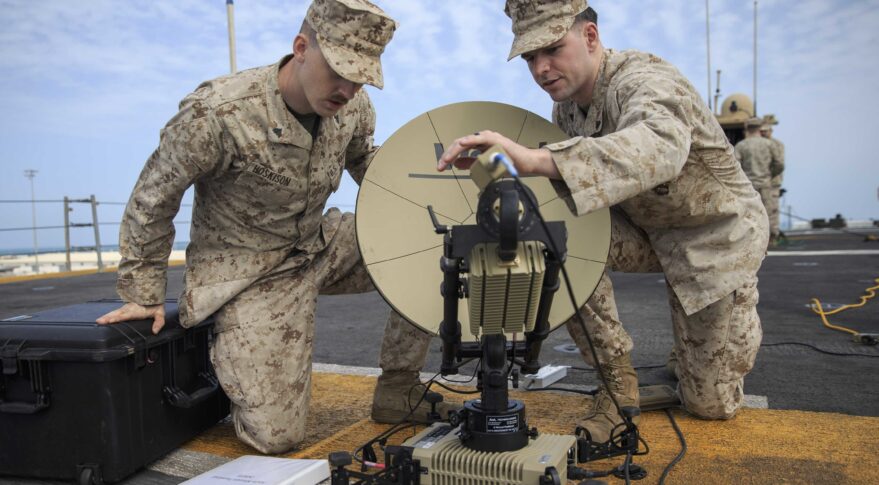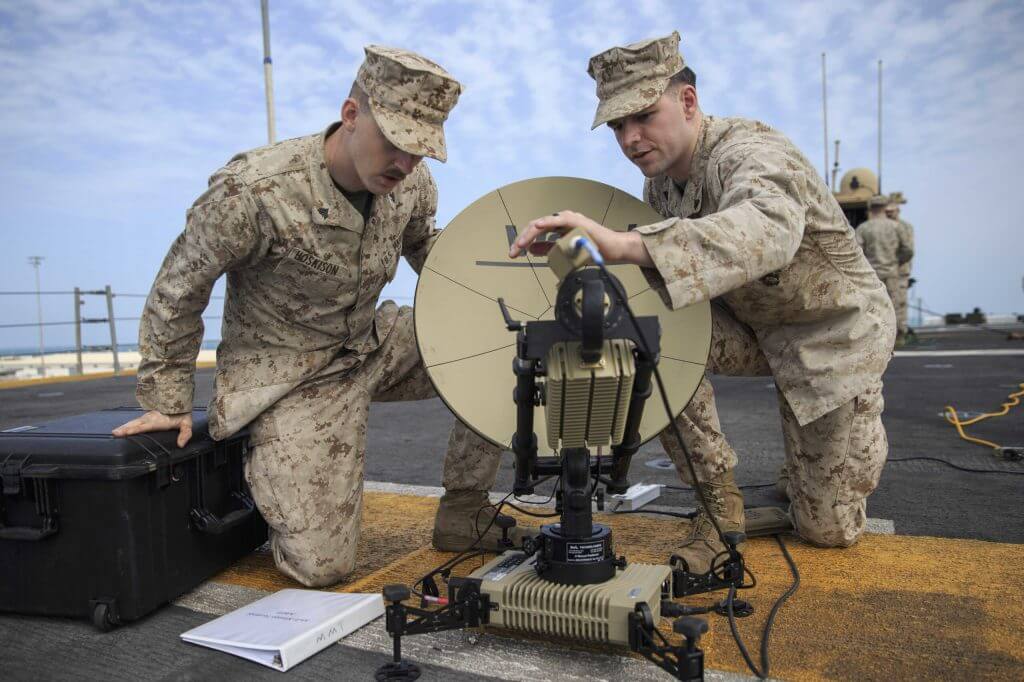
ORLANDO, Fla. — An often-heard complaint about U.S. military satellites is that they’re not resilient — which generally means they don’t have enough protections against modern electronic jammers, advanced lasers and cyber hacks.
This is a growing concern for the Pentagon as Russia threatens to extend the war against Ukraine into space, and China continues to roll out advanced technologies that could be used against U.S. and allies’ communications and navigation satellite networks.
But what it will take to make constellations more resilient and achieve what the military calls “space superiority” is still being debated, industry executives said March 4 at the Air Force Association’s Air Warfare Symposium.
The executives spoke at a panel discussion moderated by Lt. Gen. Michael Guetlein, commander of the Space Systems Command, who noted that the topic of space superiority was rarely discussed in public up until recently and is now a top concern for the U.S. Space Force.
When the military talks about space superiority, it’s not about conquering actual sectors of the space domain but ensuring that satellites can provide capabilities, such as communications, navigation, and intelligence to military forces on the ground.
“The dialogue that we should have is on how do we achieve that,” said Erich Hernandez-Baquero, executive director at Raytheon Intelligence & Space.
“The doctrine today for space superiority is basically having freedom of action and denying the adversary that freedom of action,” he said. The U.S. military’s global networks that depend on space systems have to be able to face “stressing scenarios like the defense of Taiwan.”
To ensure satellites networks can overcome cyber attacks and other threats DoD will have to change how it deploy and equips satellites, Hernandez-Baquero said. “Maneuver is becoming increasingly more important, as well as all the logistics and supply chains that are going to support any sort of response.”
The next generation of U.S. space systems also needs to leverage technologies like artificial intelligence and machine learning so they can autonomously defend against attacks, he said.
There is some confusion across the industry on what DoD means by resilience, said Bryan “Stu” Eberhardt, senior director of global sales and marketing at Boeing Space & Security.
“It depends on what you’re trying to do,” he said. “Are you really trying to get asset resiliency or are you trying to get mission resiliency?”
Asset resilience in this case is protecting the actual satellites. But mission resilience is ensuring that objectives can be accomplished even if some satellites are lost.
“We used to play those war games where you looked at reconstitution. And it would take you two years to reconstitute a satellite,” he said. “That’s totally unacceptable.” If a satellite is taken out by an adversary, how can DoD replace that asset quickly, Eberhardt asked. “Are we reconstituting from on orbit? Or are we going to reconstitute on the ground and have that capability ready?”
Eberhardt noted that in air warfare strategy, it’s assumed that some aircraft will be lost. How that approach could apply to space is “kind of danced around a lot,” he said. “The air domain accounts for attrition. If you’re going to get into a fight, you’re accounting for losses. And they build that into their acquisition process.”
“I think we’ve all recognized that freedom of action is under threat,” he said. So the traditional methods of building satellites for uncontested operations no longer apply.
“I would offer that industry’s role is to let the engineers start thinking that way,” he said. “Classically, the engineers that were designing space systems weren’t thinking too much about what kind of resiliency features I need to have.”
Once you start “running vignettes with engineers, it’s amazing the kind of innovation that they can come up with and design into the system,” he said.
Sherman Johns, director of space strategy at SAIC, said the Space Force also needs modern technologies to train satellite operators for space warfare and to test systems for how they would perform under attack.
All that is now achievable with digital engineering,” he said. “We’re all aware here that the United States no longer operates in a benign environment,” so the Space Force needs a “robust training infrastructure with models, simulations and visualization tools that allow commanders to look at a problem and actually make decisions in a timely manner.”
Working with commercial systems
Guetlein said there is an ongoing discussion about how DoD should operate with commercial space systems during a conflict. “When we were in Afghanistan and Iraq, it was clear to us what was Title 10 [military], Title 50 [intelligence] what was commercial, what was allied,” he said. “We drew very bright lines between them.”
But the lines between government and commercial could become more blurred if DoD starts buying more commercial services, Guetlein said. “As we start going into the space fight and seek space superiority, there are those in a camp that says the government has to own all the capability on orbit.” However, he said, there is now a push to make hybrid networks where commercial and military systems are integrated.
Eberhardt said the industry has struggled to move forward with the design of hybrid networks because policies are still clear. “The government has a policy debate on their hands on the use of commercial assets and what happens” during a conflict.
He said other countries that buy satellites from Boeing have asked the company for communications services that go across the military and commercial Ka band, for example, but the U.S. government has not. DoD also has to think about what investments it will need in ground terminals that can talk to military and commercial satellites. “You can put satellites on orbit but if you haven’t thought through the ripple effects of what happens to the rest of the system all the way down to the end user, you start running into trouble.”
“As you’re thinking about commercial versus government, you do have to get down to what’s the minimum viable product the warfighter needs to win the war,” Eberhardt said.
Johns agreed that the question of how to blend military and commercial space systems “has been sort of asked forever and we haven’t cracked the code.” The policy “needs to be defined by the U.S. government,” he said. “And industry will obviously follow suit.”
“What’s a minimum viable product, and commercial versus not, this one’s just hard,” Johns said.
Business and investment strategies
Another issue executives brought up is how the government communicates its demands.
Hernandez-Baquero said a new Space Force organization, the Space Warfighting Analysis Center, is reaching out to the industry and sharing data about space threats so companies can design systems accordingly.
But more information is needed about the threats that U.S. satellites face so the industry can “really align our investments to make sure that we are ready with the capabilities that the government is going to need,” he said.
The Space Force says it wants to buy more commercial space services rather than build its own satellites “but there needs to be a good market signal that industry can then say, okay, if I put the investment in this area, I’m going to get a return because I know this is a capability that the government needs,” said Hernandez-Baquero.
That helps companies prepare “ahead of time rather than react to a solicitation when it comes out,” he added.
“When you look at the capital investment that’s happening in the commercial world on software, digital technology, artificial intelligence, machine learning, modeling and simulation, autonomy for vehicles and 5G networking, there’s just huge capital that’s going into commercial,” Hernandez-Baquero said.
“I haven’t seen this kind of energy around space, outside of defense, that we’re seeing now. So that’s really good,” he said.
But the government has to figure out a business model to leverage commercial investment, he added. “When you look at the value that warrants the investment that commercial puts into these technologies, it’s because there’s scale,” he said. “But when you look at the way we’re selling these sort of technologies in the government, we’re not doing it that way” due to specific requirements that DoD has that don’t exist in the commercial world.

